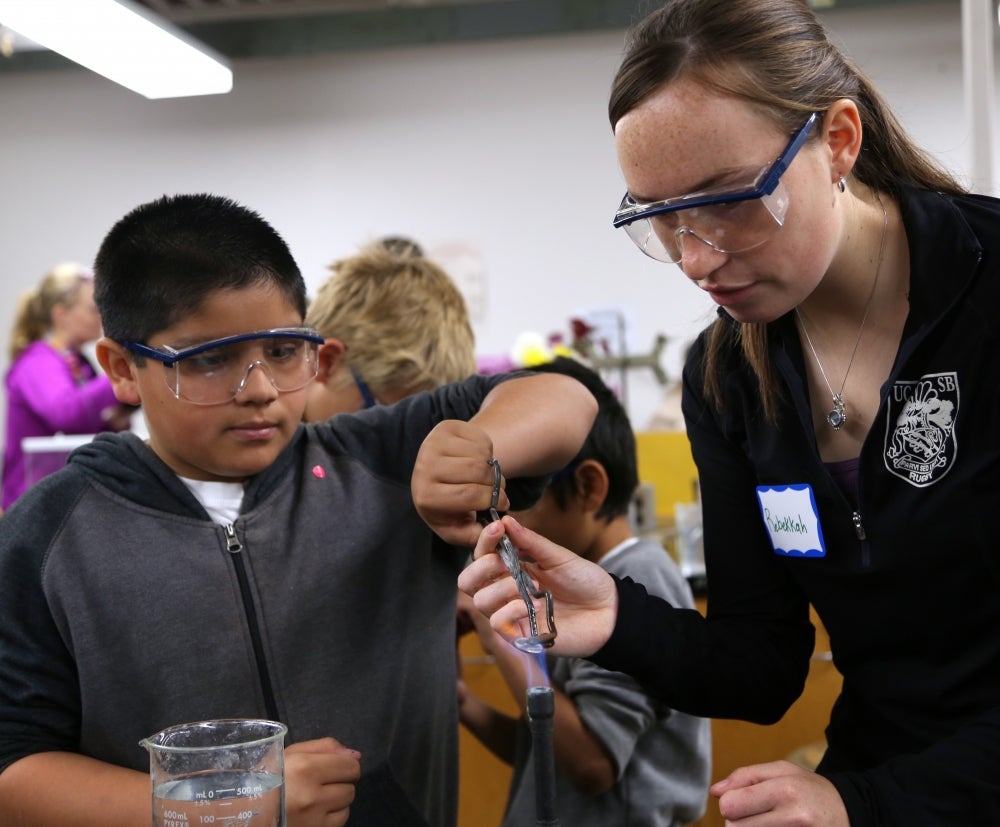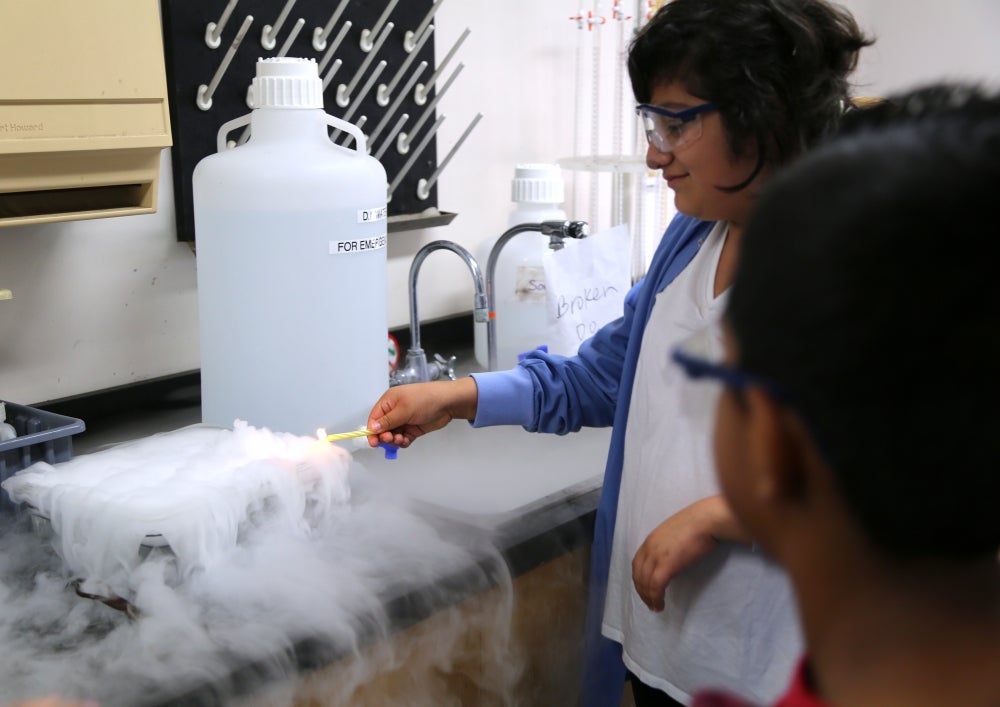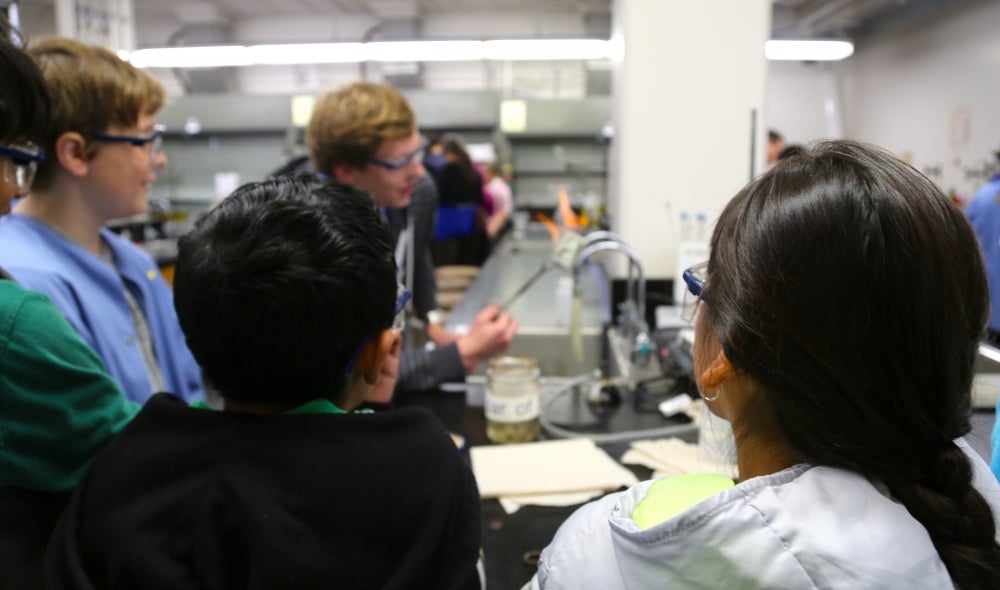Chemistry Outreach Program Encourages Fifth-Graders




Ann Marie Galbraith’s class could barely contain themselves as they got off the bus. Their destination: UC Santa Barbara and the lab used for the chemistry department’s Fifth-Grade Outreach Program. The students, from Santa Barbara’s Monroe Elementary School, were primed by their own school’s science fair, which took place a week before their visit to UC Santa Barbara.
Ecstatic was the word Galbraith used to describe the students’ enthusiasm. “The type of hands-on experience they get in a UCSB lab is just priceless. It cannot be recreated in a classroom or in a science lab at an elementary school,” she said.
The lab hosting the students contains five stations, each focusing on a different aspect of chemistry: dry ice, combustion, liquid nitrogen, alloys and polar versus nonpolar interactions. For combustion, the activities included lighting methane bubbles and trying to burn a dollar bill dipped in alcohol and water.
The alloys station was a student favorite. There, the fifth-graders made a brass alloy from copper and zinc. First, the students were given pennies turned silver in a near-boiling solution of sodium hydroxide and zinc. Then, with tongs, they held their coins over the flame of a Bunsen burner until they turned to “gold” (actually a brass alloy).
Another station favored by the fifth-graders was liquid nitrogen, where they learned about liquids, solids and gases. The students froze flowers and deflated and reinflated a dog-shaped balloon to explore the kinetic energy of molecules as a function of temperature. They shattered a racquetball that had been soaking in liquid nitrogen throughout the whole lesson.
“It is a shock because they have never experienced this,” said Galbraith. “We don’t have Bunsen burners; they don’t get to blow up things.”
UCSB’s Fifth-Grade Chemistry Outreach Program, now in its 15th year, is designed to nourish natural curiosity in science and to stimulate an interest in science education. The program focuses on fifth-graders because the California physical science standards for that grade include many advanced and complex scientific concepts grounded in chemistry. These standards provide an opportunity for students to experience creative scientific thinking. More than 1,400 fifth-grade students, teachers and parent volunteers participate in the UCSB program each year.
“If I had been exposed to science earlier, I would have been excited much earlier, and that’s another reason why we work with fifth-grade students,” explained program developer Petra van Koppen, a senior lecturer and undergraduate adviser in UCSB’s Department of Chemistry and Biochemistry.
“I feel like we are making a difference,” said Darby Feldwinn, a chemistry lecturer specializing in chemistry education. To kick off the program, she performed feats of chemistry magic. For her first trick, she added soap and a catalyst, potassium iodide, to hydrogen peroxide, which resulted in a tube of foam erupting out of its graduated cylinder. In another demonstration, Feldwinn combined different liquid solutions that created a series of changing colors and even glowed in the dark.
The demonstrations gave students the opportunity to engage chemistry directly and to get a firsthand look at chemical reactions. “You can show them things and you can get them to think for themselves,” Feldwinn said. “A lot of the time, they’re just trying to regurgitate things, so when they get excited, they start thinking and that’s the most exciting part of this program.”
The student mentors also benefit enormously from the opportunity to share their love of science with the fifth-grade students. Freshman Kevin Dervishi jumped at the chance to get involved in the program. “I just love working with the kids and sharing my enthusiasm for science,” he said.
Dervishi manned both the dry ice and liquid nitrogen stations for two different fifth-grade classes. “We not only get them thinking scientifically but we work in secondary lessons that apply to real life,” he said, speaking of the dry ice segment that explores the acidic content of soft drinks.
The entire experience enriches these fifth-graders in unforeseen ways. Not only did Galbraith have her students write a journal entry once they returned to school, she later had the class review its science fair projects together to see how they could have been made more challenging using what they learned at UC Santa Barbara.
“I also saw an opportunity to extend what they learned by exploring the language arts aspect of science,” Galbraith said. “The program makes teaching real. The fact that my students can set foot on a university campus, in a university lab, and know that they have done this, gives them hope, something to reach for.”



